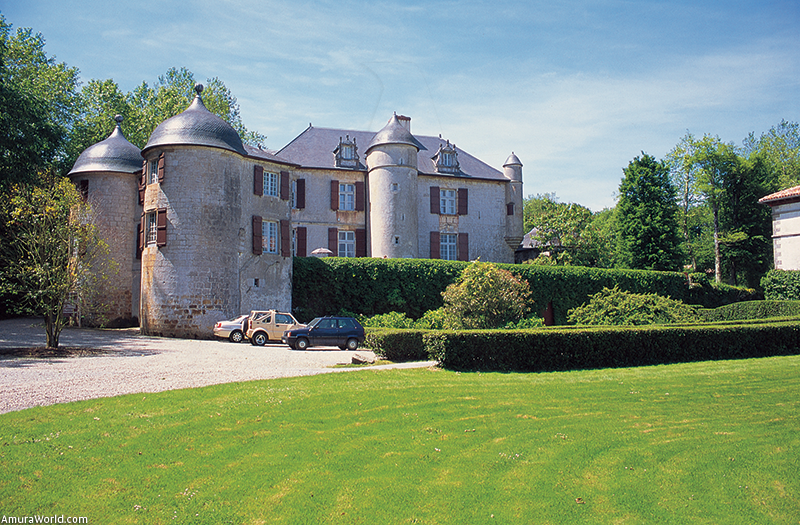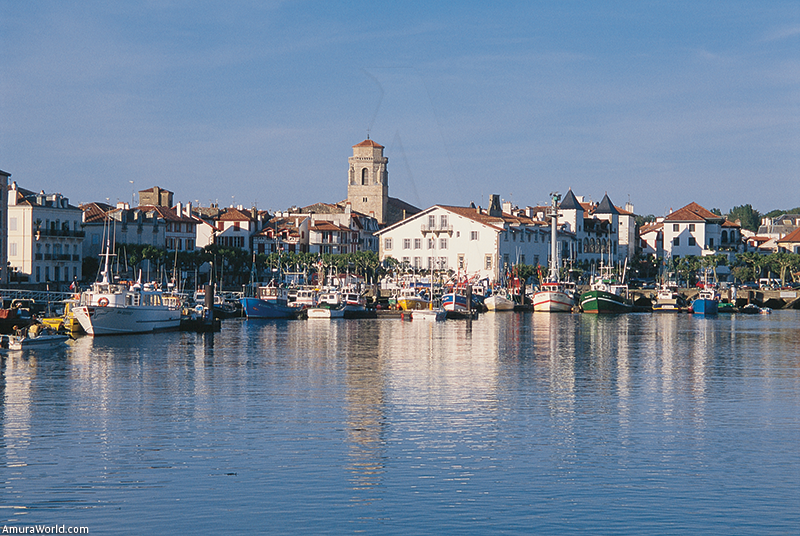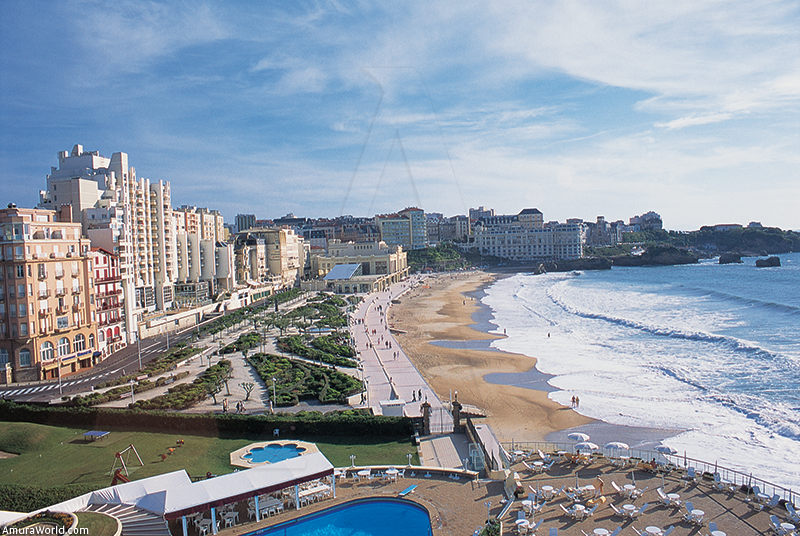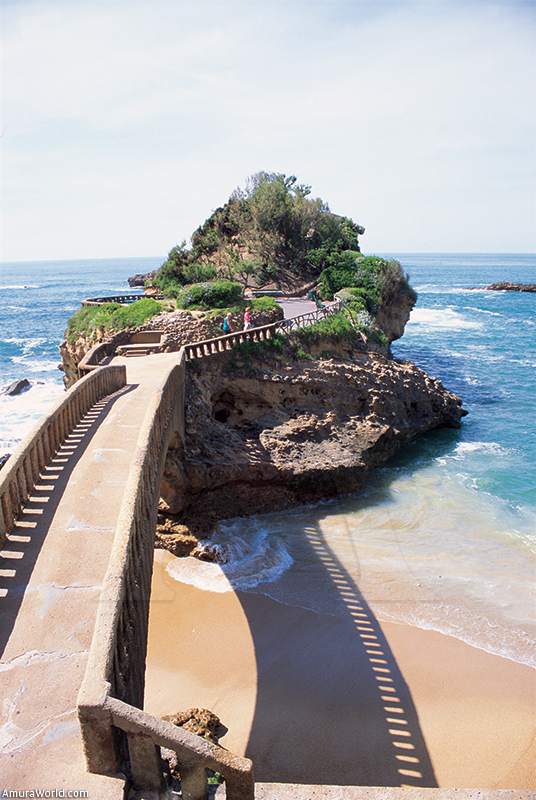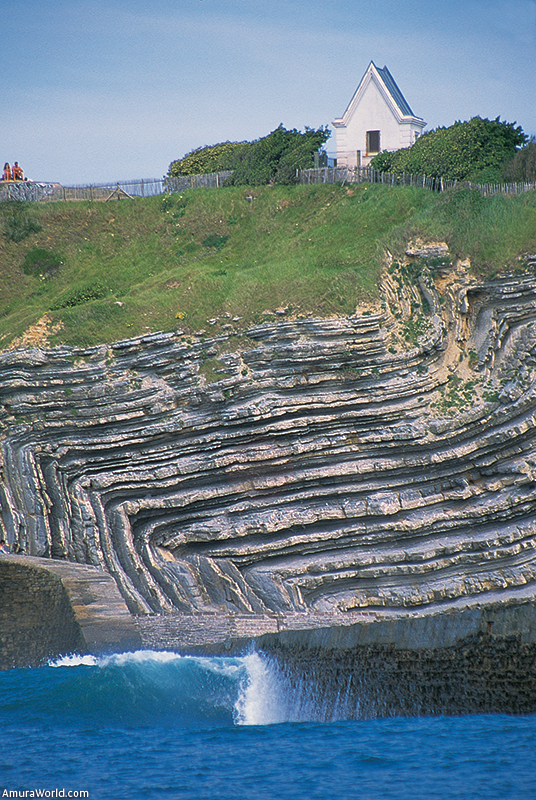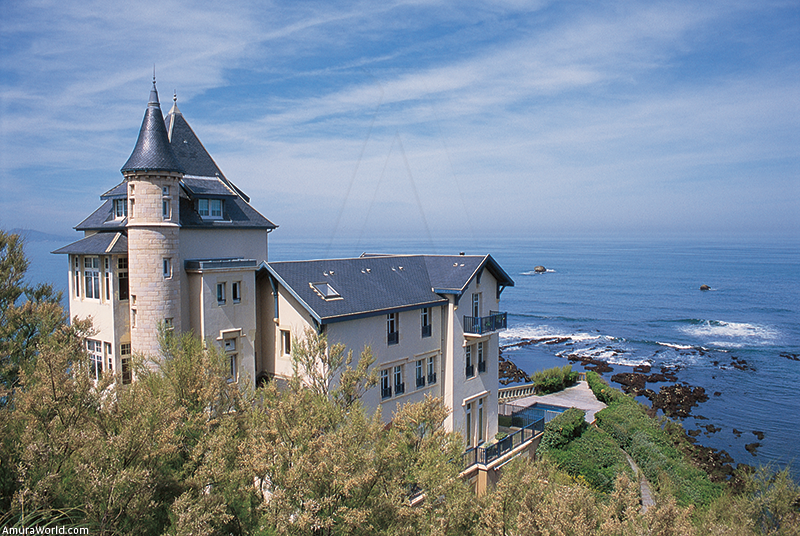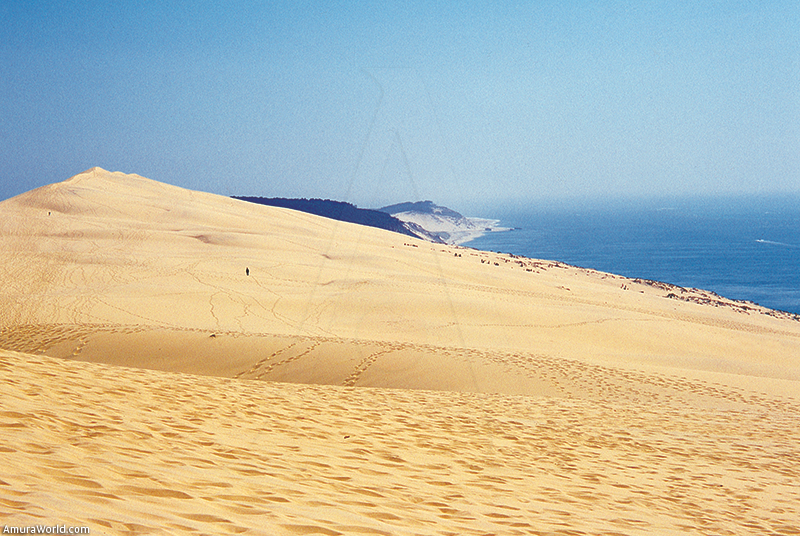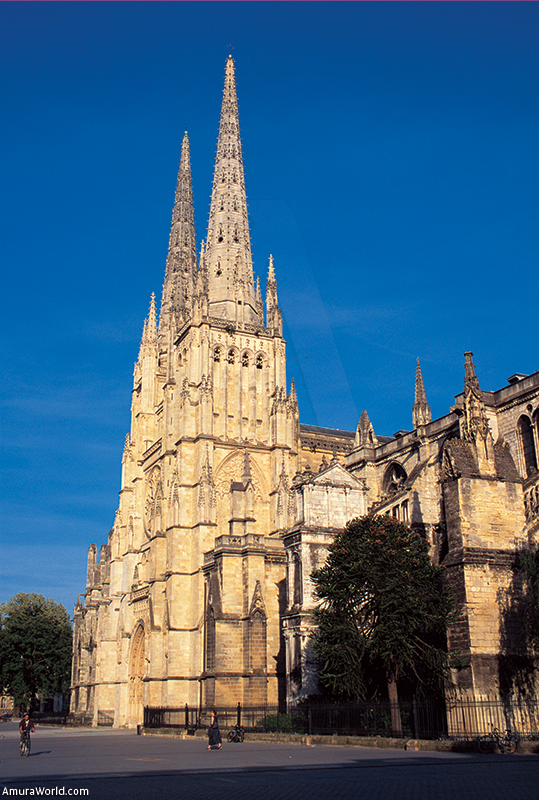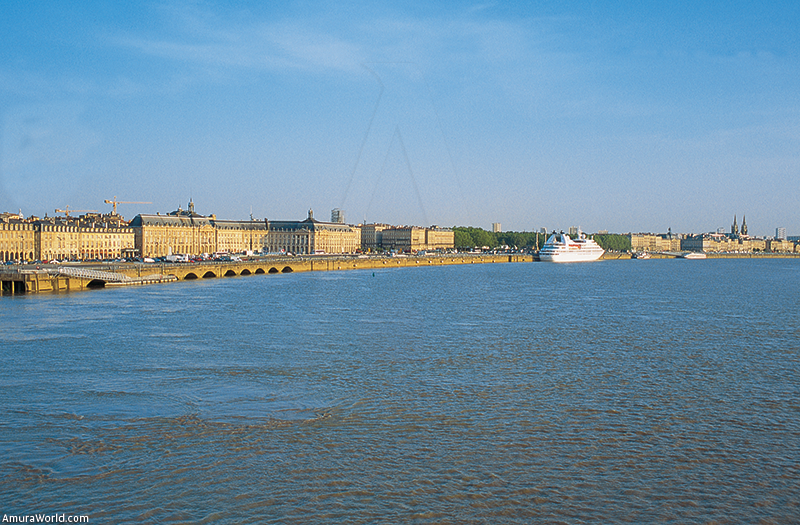The french Basque Coast and The Landes from Hendaye to Bordeaux
From the green hills that descend from the Atlantic Pyrenees to shape the French Basque Country to the pine-covered plains that form the Landes, the coast invents a quantity of surprising cliffs and ends in long beaches of golden sand. On land, seductive towns beckon you to discover their culinary arts and traditions, a number of beautiful lakes inhabit the pine woods and the people are intriguing because of their strong personalities and customs.
Hendaye-Saint Jean-de-Luz
Our small yacht, on which we would discover the coast up to Bordeaux, a marvelous region of France, was waiting for us in Hendaye. The old section of Hendaye is dominated by the Saint Vincent church and you can feel the old frontier ambiance of the city even though the borders have now been removed. On the other side of Chingoudy Bay we found the Spanish city of Hondarribia, with its very active fishing port and imposing abbey, where Charles V once stayed and which is now a hotel. Here, time has stopped, the restaurants invite you to discover Spanish cuisine and the market is where authentic Spain begins.
Following the coast to Cabo de la Higuera we found a series of small bays, ideal for anchoring and walking along these green slopes of the Pyrenees that plunge into the sea. Declared a national park, it is a forest that contrasts with the blue sea and where the waves attack the small isles that are the homes of birds.
Cutting straight across from the entrance to Chingoudy Bay with its long beach, we reached the Chateau d’Antoine D’Abbadie. Built by Eugène Viollet-le-Duc in 1860, it is of neogothic architecture with a touch of Oriental passion. Antoine D’Abbadiem, a great traveler and Ethiopia’s first cartographer, set up an observatory in this castle of spiked towers that guards the sea. Surrounded by the Abadía Ecological Reserve, it is like a ghost emerging from the past.
We followed this coast outlined by surprising cliffs, where the uneven, inclined layers have formed a strange scene drawn by the sea. In the meadows the sheep looked like white spots on the dazzling green and, further along, the waves raised a humid, clear fog. We passed the Sainte Barbe point to enter the great Saint Jean-de-Luz Bay, guarded to the south by the small town of Socoa, dominated by its fort, and, to the north, by a cliff. A beautiful beach borders the city, a magnet that attracts people in the summer, and the Nivelle River flows in to the bay. In this river, that separates Ciboure and Saint Jean-de-Luz, we found the marina and fishing port, where boats are reflected in the water lying at the foot of the church’s tower.
Romantic Ciboure, with its beautiful Saint Vincent church (16th century), famed Bourdagain Tower (14th century) and ancient fountain (17th century), is the city where Maurice Ravel was born. Its rival and companion, Saint Jean-de-Luz, with its typical narrow streets that surround the Saint John the Baptist church, with its marvelous altar and wood banisters, is livelier. The church is where, in 1660, Louis XIV married the Spanish infanta María Teresa of Austria. After the wedding the door, through which the bride and groom entered, was sealed. We visited the houses where the king and the infanta lived as well as the very vibrant streets framed by Basque houses with all manner of shops, and discovered the famed “macaron Adam”, an exquisite type of marzipan.
We stayed at the enchanting Les Jardins de Bakea hotel, a large house in the heart of the countryside. It has a sophisticated restaurant that serves an excellent duo of leeks and foie gras.
Basque Towns, Arrière Pays
Our land exploration led us to discover the French Basque Arrière Pays, with its fascinating towns nestled in the green hills at the foot of the Pyrenees: Ascain, with its typical church with square tower and indoors wood banister, fronton and typical houses; Sare (from where we took the rack train that took us up to the La Rhune peak at 900 m (2,953 ft) and Aïnhoa, two towns that live to the rhythm of the small bells of its cows and where you can experience the music of the art of living; Espelette, with its castle and famous chocolatier Antton; Cambo-les-Bains, with its thermal centers and the fascinating Arnada (the mansion of Edmond Rostand, the renowned writer of Cyrano de Bergerac). We explored the d’Urtubie Castle, with its aggressive round towers, and the coastal towns of Guéthary and Bidart, two intriguing locations that dominate the sea, where life revolves around its fronton and the fishing port and which is adorned by beautiful Basque houses.
Saint Jean-de-Luz- Biarritz
We followed out nautical route along the length of a cliff cut out by beaches where surfers wait for waves, admired mansions that overlook the spectacular panorama and sailed along the border of the golf course, one of the most beautiful in Europe. After an hour we reached elegant Biarritz, with its genuine palaces built on the rocks and the “Palais”, which stands as a witness to the life of this great city and where we stayed after docking the yacht in the small port lying at the foot of the cathedral. Le Palais is a fabulous, graceful hotel that was originally the “Villa Eugenie”, the summer home of Napoleon III and Empress Eugenie, who had become enamored with this place. They made Biarritz and its fine air fashionable and the nobility built their mansions there.
In 1892, the Republic replaced the Second Empire, the Villa was turned into a hotel and the aristocracy arrived, the city was adorned by beautiful residencies and this beautiful era was lit it up by its casino, theater, parties, movie celebrities and European elite. It was crowned the queen of the Basque Coast. The “Rocher de la Vierge” is a group of rocks lashed the strong waves, protected by a Virgin that appears to direct the ocean, and the lighthouse encloses that beautiful beach adorned by the Le Palais, other hotels and Talasotherapy centers, the casino, the church and the houses with unusual witch-hunting towers.
Biarritz, that charming, international corner of the Basque Coast, is a beach for surfing or for being seen and the city is perfect for enjoying the cuisine and celebrations.
Biarritz-Hossegor
After enjoying the elegant city, its exquisite gastronomy and the charm of “Le Palais”, we continued on our route towards the north to discover that, passing the Biarritz lighthouse and all the way to Bordeaux, we would encounter a flat coast of long beaches of golden sand and hard waves. Passing Anglet and a strong barrier we entered the mouth of the Adour River and reached Bayonne, an authentic, active city where the ruins of the wall built by Vauban attest to its glorious past. It is the city of museums, celebrations and bull fights, of narrow streets and cafes located at the foot of its imposing gothic cathedral and of its once important inland port, about 5 km (3.10 mi) from the sea.
Coasting, we began to discover the Landes region, that sandy plain where pine trees grow and among which cozy towns are hidden. Here is where you will find Dax, the queen of the region, an ancient Roman city and an important curative center thanks to its spring of natural, hot thermal waters. We passed beaches protected by dunes (Tarnos, Ondres, Labenne and Capbreton - an important vacation center) and discovered Hossegor, whose beaches are full every summer. Entering through the port and leaving the marinas, we dropped anchor in the lagoon in front of the amazing Les Hortensias du Lac, a chic, elegant hotel.
Graceful Hossegor is a group of beautiful homes hidden in the forest and around the lagoon, with a popular center, golf course and a long beach ideal for surfing enthusiasts. The restaurants vie in innovations and the good taste of the local products and foie gras is always present in the menus. Capbreton is its rival and is equally beautiful and Seignosse is proud to be the best place for surfing. There are 331 regional celebrations in the Landes region, many with typical dances, men parading on stilts, bull fights and runs.
Hossegor-Arcachon
We expected a long day of sailing along the coast bordered by beautiful dunes protected by the Landes pine trees. The forest was planted at the end of the 19th century in order to drain this vast area of swamps and sand. The coast is an almost straight line of unending beach, interrupted only by a few rivers that flow into the sea and in Mimizan, when we entered the river, we discovered the d’Aureilhan Lake in the heart of the pine forest. Finally, we reached the d’Arcachon point to enter in the mouth of the great Le Bassin D’Arcachon Lake. Here, we were in front of an impressive panorama: the great Pilat dune, an imposing mountain of sand 105 m (345 ft) high, 2.7 km (1.67 mi) long and 500 m (1,640 ft) wide. It is a fragile giant, reduced to the east by the ocean and the wind, and, from the top, the view opens towards the estuary closed by Ferret Cape, where the sand banks, “le Banc d’Anguin”, change to the rhythm of the tides and form a natural reserve for birds.
After admiring this impressive scene we entered Le Bassin d’Arcachon, with its bird island, which, at high tide, has 300 hectares (741 acres) and, at low tide, 1,000 hectares (2,471 acres); and the “tchanquées” cabins. These cabins on stilts (“tchanque” means stilts in Gascon, the local language) were built by the caretakers of the oyster farms and their surprising silhouettes, symbol of the Bassin, stand out against the horizon. The renowned, exquisite d’Arcachon oysters are a delicacy served in Parisian tables.
The Leyre River flows into the Bassin, creating a wild delta with many ramifications, abundant vegetation and a great variety of birds. This is why the Teich Ornithology Park was created here. Located in the migratory path between north Europe and Africa, it has an area of 120 hectares (296 acres) and over 250 species
The Bassin offers more than 3,500 places to dock and from where you can set out to discover the enchanting beaches though sailing is difficult because of the currents, sand banks, tides and oyster farms. At low tide, two thirds of the Bassin is exposed and sailing is done in the canals. La Pinasse, the traditional boats painted in bright colors and created over 350 years ago, have a low floating line, flat bottom and a small cabin towards the front but its two extremes are the same, which permits them to sail both ways without turning around, making them very practical on the canals where the water is shallow.
Standing sentinel on a dune, Arcachon is a marvelous city guarded by the Bassin and it owes its growth to the trend, initiated at the beginning of the 19th century, of bathing in the sea. The gorgeous mansions on the hills, ranging from massive to Spanish-Moor style, adorn the winter city and are hidden among the vegetation of the extravagant gardens. The summer city is in the low part, near the edge of the sea, with a casino built in 1853, a seaside promenade, marinas, cafes and restaurants, shops and basilica, with a sailor’s chapel whose walls are covered in exvotos thanking the miraculous Virgin. In the east part is where we found the houses with low tile roofs where the fishermen lived.
Archachon enchants because of its oceanic climate and Atlantic air, seduces with its shady streets and elegance, amazes with its Bassin and mysterious ecosystem. At the entrance of the Bassin, the Ferret Cape has become a place of exclusive, stylish homes.
Arcachon-Bordeaux
Bad weather obligated us to leave the yacht in Arcachon and reach Bordeaux, 60 km (37 mi) away, by land while, by sea, we would have had to make a long journey to the de la Grave point to enter the de la Gironde estuary, into which the Garonne and Dordogne rivers flow, and follow the Garonne to reach the Bordeaux port, which receives great ships.
Bordeaux, the world’s capital of wine, is an authentic majestic city with elegant mansions of the 18th century that luxuriously adorn the bank of the river, avenues and parks. In its ancient heart, the narrow streets remind one of its medieval past, the small plazas astonish with their cafes and fountains and the Saint André cathedral rises with its gothic arrow in this elegant world of carved stones on which unique masks appear.
The Cours de l’Independance is the ideal place for discovering the de la Comédie plaza and the grand theater, the Saint Michel neighborhood invites one to visit its market and Sunday “brocantes” (street market of antiques and used objects) at the foot of the monumental church while the Saint Pierre neighborhood, the “vieux Bordeaux”, is a thimble of enchanting streets. The long dock that borders the river, with its mansions and elegant buildings, is a very pleasant stroll as is a walk in the public gardens with their fountains.
For a nice rest we chose the Las Sources de Caudalie, a fabulous wine therapy center some 30 km (18.6 mi) from Bordeaux, a place where you can enjoy treatments based on grape residue in a spot surrounded by vineyards and where you will find the best wines, like Chateau Smith Haut-Lafite.
We had explored almost the whole lengthy 250 km (155 mi) -long beach, from the border to the la Gironde estuary, a coast of dunes protecting pine forests, where the pines obstruct the sand’s invasion of the land, where the southern cliffs are adorned by gorgeous houses that are open to the beautiful bays. From The Basque Country to la Gironde, passing through the Landes, the coast, filled with traditions, culture and good living, is a region of fantastic cuisine and fabulous wines. The sail becomes a tasty, enlightening journey and the Aquitaine region conquers with its beauty, its strong sea with a trace of iodine and its secret charms that bewitch with its refined flavors. It is a very seductive French region.
Text: Patrick Monney ± Photo: Patrick Monney.



